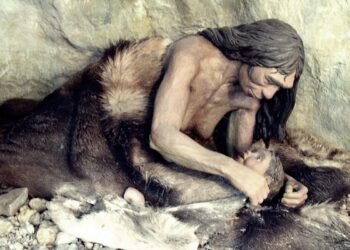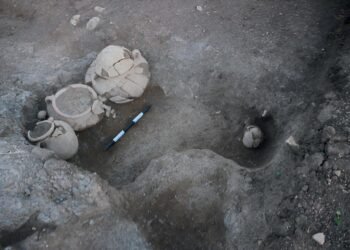Archaeologists in Chifeng, Inner Mongolia, have unearthed an ancient dragon crafted from mussel shells. The discovery has been associated with the Hongshan Culture, a Neolithic civilization that thrived in Northeast China’s West Liao River Basin from 4700 to 2900 BCE.

According to Hu Chunbo, the director of the excavation project at the Caitaopo Site in Chifeng, the 20-centimeter-long dragon’s head, body, and tail are assembled from a number of mussel shells like a jigsaw.
The mussel shell dragon was unearthed at the Caitaopo site, along with fragments of two pottery wares typical of the Hongshan Culture. The presence of these artifacts in the same archaeological layer dates the dragon to the early period of this ancient civilization, making it much older than the previously known C-shaped jade dragon.
Unlike the abstract C-shaped design, this mussel shell dragon exhibits a higher degree of realism, with minute details painstakingly carved into the shells’ surfaces.
The dragon’s head, body, and tail are meticulously assembled from mussel shells, creating a lifelike representation. Notable features include delicate teeth and rhombic scales on the tail, all expertly carved into the shells’ surfaces.
The dragon’s mouth is short and wide, and a pierced circular hole serves as its eye, located beneath the forehead. Four additional circular holes at the tail’s base suggest the possibility of connecting the dragon’s parts using a string threaded through these openings.
Song Jinshan, President of the Inner Mongolia Institute of Cultural Relics and Archaeology, emphasized the dragon’s historical significance. He explained that this discovery has significantly enhanced our comprehension of the dragon symbol during the early stages of the Hongshan Culture, marking a breakthrough in archaeological knowledge.
The Hongshan Culture, a hallmark of the Neolithic era, flourished in the West Liao River Basin and spanned from the Inner Mongolia Autonomous Region to Liaoning. The culture’s rich heritage is exemplified by its exquisite carved jade artifacts.
While the previously discovered jade items from the Hongshan Culture were primarily associated with high-grade ceremonial structures or ritual sites, the mussel shell dragon unearthed during this excavation offers valuable insights into the spiritual world of people residing in low-grade settlements within this civilization.
The dragon symbol, deeply rooted in Chinese cosmology and revered for its associations with power and auspiciousness, has now been revealed in a more intricate and realistic form.






















